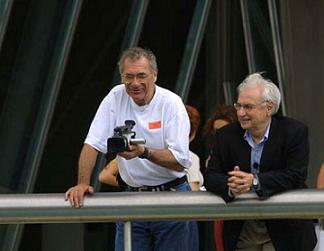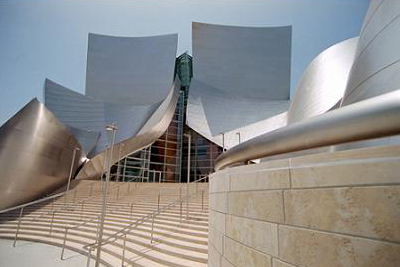

For years, people have asked architect Frank Gehry if they could make a documentary about him and his work. Gehry rebuffed them all, and asked his longtime friend director Sydney Pollack (The Interpreter, Random Hearts) to direct one. Pollack was a bit confused, since he never directed a documentary before and did not know much about architecture, but it turns out that this was exactly what Gehry wanted. Sketches of Frank Gehry feels less like a documentary and more about an insightful conversation between two friends about art and architecture. Because the two are friends, it allows Gehry to be extremely relaxed and open about his work. It's not exactly a deep probing documentary, but it is a nice primer on Gehry and his work.
People know Gehry best for his unique style of architecture. His buildings are beautiful works of metal that look like somebody crumpled a piece of paper together. There are swoops and flourishes that seem to defy gravity, and as weird as they look, all of his work is highly compelling. Most notably are works like the Guggenheim Museum in Bilbao, Spain, and the recent Walt Disney Concert Hall in Southern California. Pollack travels to many of the locations, beginning with the small house that Gehry and his wife bought in Los Angeles, and interviews many of the people currently associated with the buildings. Dennis Hopper (Land of the Dead, Out of Season) owns a Gehry home, and artist Julian Schnabel (decked out in a huge white robe) talks a bit pretentiously about why his art belongs in a Gehry museum.
The reason that artists flock to Gehry is that he thinks like an artists. The strict conventions of architecture mean little to him. He became successful after he began doing his own thing. He understands how to use natural light to its fullest potential, and has legions of followers everywhere, with only a few naysayers (Pollack interviews one). Gehry has worked with the same group of people in his firm for over a decade, and now they seem to think as one. They bounce ideas off each other quickly, and can communicate quickly non-verbally.
Pollack is probably the most surprising aspect of Sketches of Frank Gehry, and one of the main reasons for its success. He keeps the conversation going, delving into many topics. Pollack, being an artist in a different medium, can ask intelligent questions about Gehry, his inspiration, and his work. He also adds in some of his own experiences and frequently appears on screen, but in an unobtrusive manner. All the while parading images of Gehry's work across the screen. This is not a critical look at Gehry. It is basically a tribute from a friend, but thankfully never droops to the level of pandering.